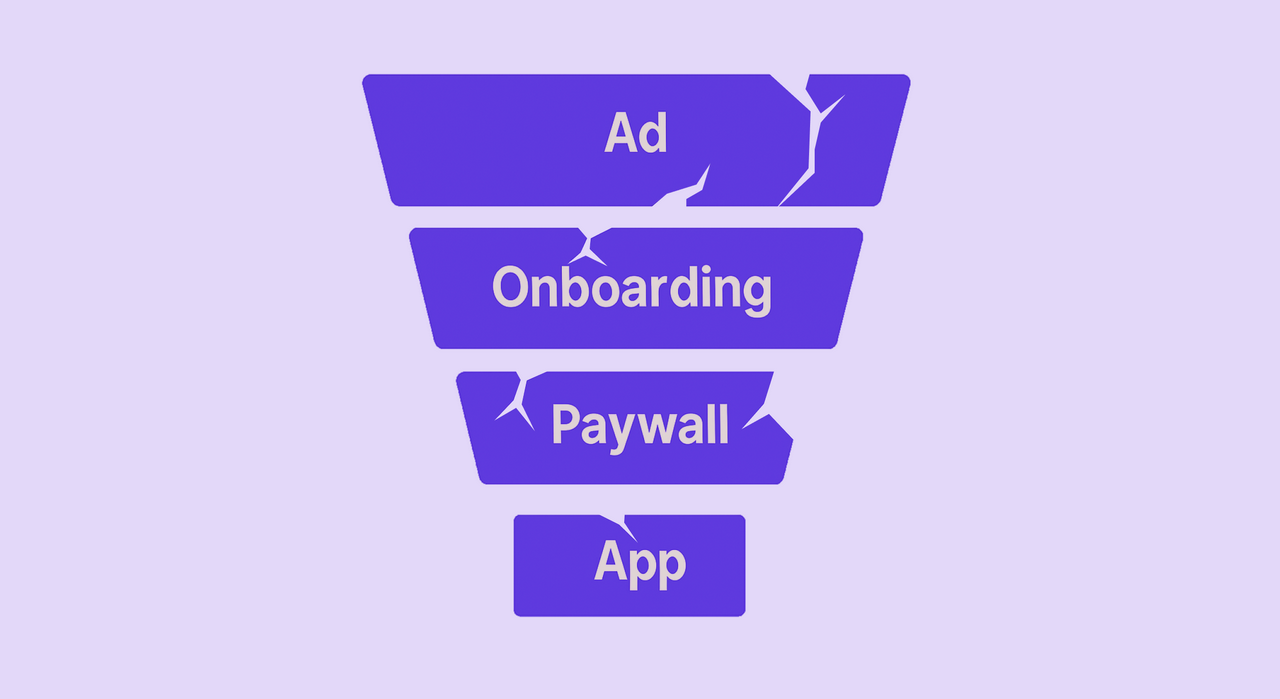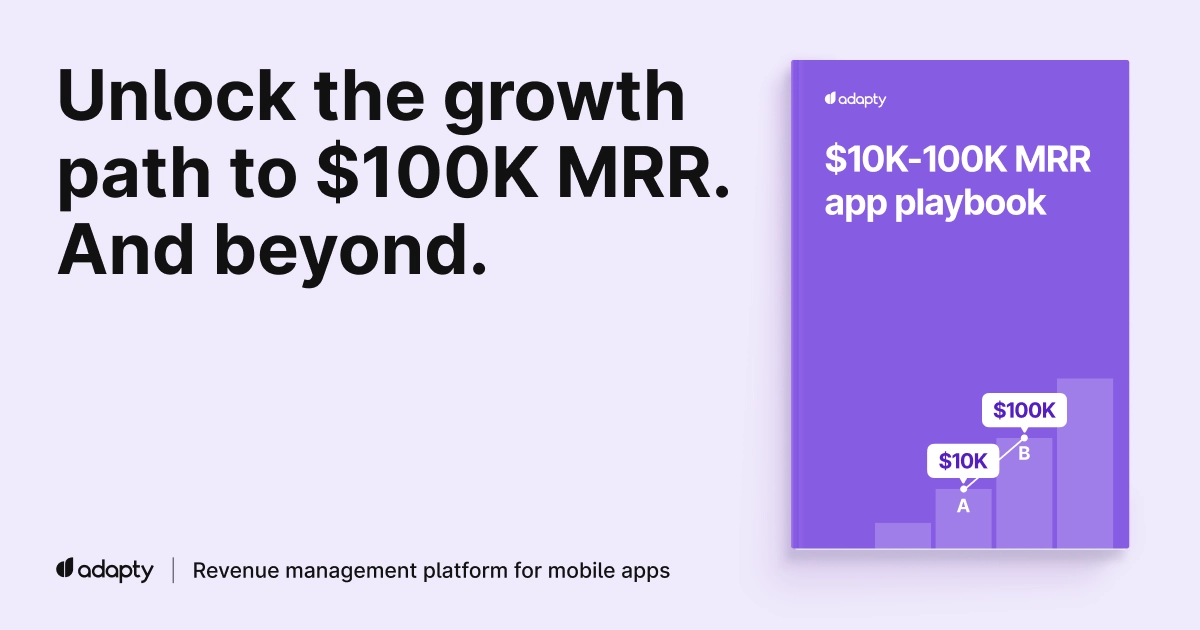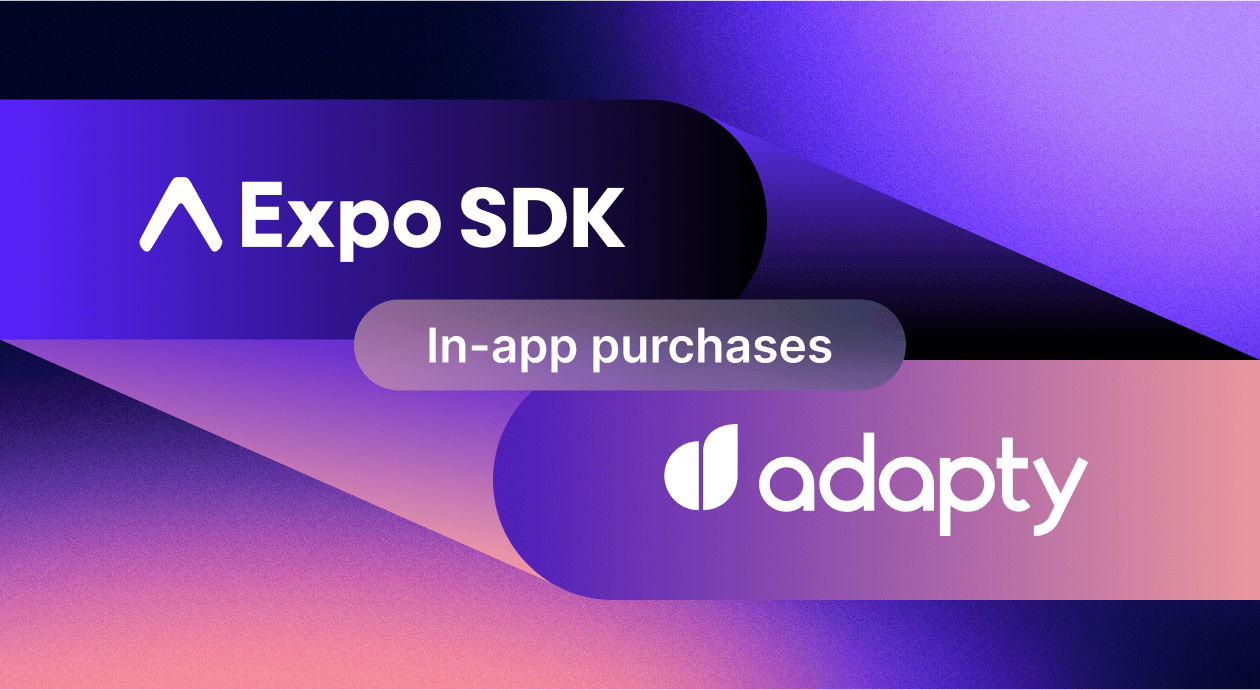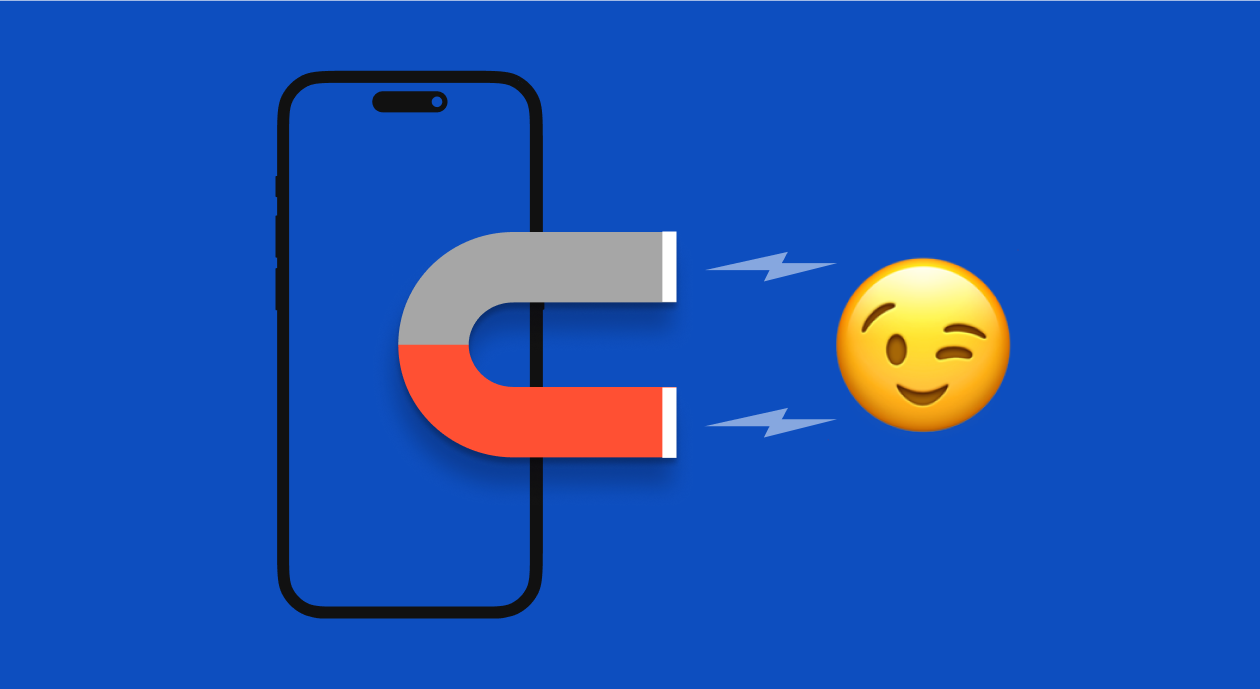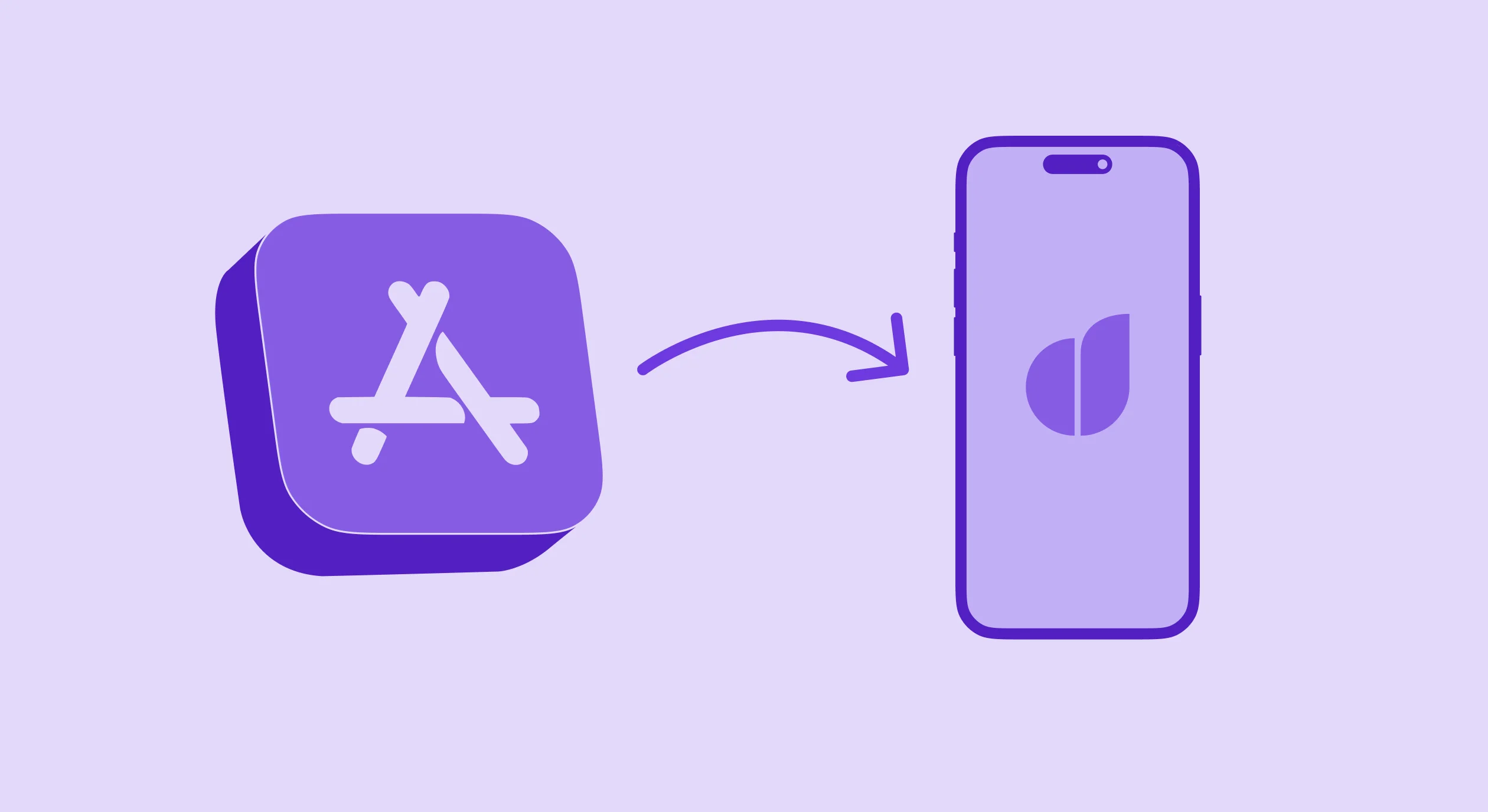Web-to-app funnels should scale your growth. They bypass platform fees, fix attribution, and give full control over the user journey. But many fall apart quickly.
This guide breaks down what’s actually going wrong, and how you can fix it.
Let’s start with the first breakpoint: your ad.
Ad creatives: where web-to-app funnels break before they even begin
Your ad is the first touchpoint in the funnel. If it fails, everything else fails too.
Here are the most common creative mistakes and how to avoid them.
Funnel killer #1: Misleading or mismatched messaging
How it shows up:
High click-through rates, but users bounce as soon as they reach onboarding or land in the app.
Why it happens:
The ad overpromises or advertises something the onboarding and the app doesn’t immediately deliver.
Think: “Free 7-day plan” in the ad, but after clicking – no mention of it. This breaks trust.
How to fix it:
- Stick to one promise across the whole funnel: ad → onboarding → paywall
- Use real screenshots or actual app footage – not overpolished renders.
- Show exactly what the user will get after clicking.
- Don’t optimize for CTR – optimize for relevance.
Funnel killer #2: No clear value
How it shows up:
Low CTR. Your ad gets ignored. Or people click out of curiosity, not real interest – and drop off fast.
Why it happens:
The value prop is too vague. Buzzwords instead of benefits. Features instead of outcomes.
Sometimes users don’t even realize it’s an app being advertised.
How to fix it:
- Lead with the outcome: “Learn Spanish in 10 minutes a day” > “Immersive language experience”.
- Show that it’s a mobile app: phone mockup, install icon, app UI.
- Use CTAs that set expectations: “Start my free 10-min lesson” > “Learn more”.

Funnel killer #3: One-size-fits-all creatives
How it shows up:
Your creatives burn out fast. They underperform on some platforms, or stop converting after a few days.
Why it happens:
You reuse the same ad everywhere. But TikTok != Instagram != Google Ads. Each channel has its own style, rhythm, and audience expectations.
How to fix it:
- Treat creatives like a product: prototype → test → kill losers → scale winners.
- Adjust for channel:
- ○ TikTok: selfie-style, authentic, snappy.
- ○ Instagram: strong professional visuals + bold copy.
- ○ Google: intent-based, text-driven.
- Refresh creatives before fatigue hits.
- Pull inspiration from competitor ads, and adapt it to your flow.

Web onboarding: why users bounce before they see value
The ad worked – users clicked and entered your web-to-app funnel. But most of them don’t make it to the next step.
Here’s what usually goes wrong and how to fix it.
Funnel killer #1: The onboarding breaks the promise
Why it breaks the web-to-app funnel
The ad sets a specific expectation – a plan, a benefit, a transformation. But the first screen doesn’t follow through. That disconnect is enough to lose the user before they begin.
How to fix it
- Make the onboarding continue the ad – same language, same value
- Echo the promise the user clicked for
- Start with a soft entry: one line, one question, one confirmation
? Onboarding must continue the ad!
Funnel killer #2: No personalization, just a form
Why it breaks the web-to-app funnel
A static, same-for-everyone flow makes users feel unseen. They answer questions, but it doesn’t affect the flow. And if there are too many questions with no clear purpose – they quit.
How to fix it
- Focus on pain-based questions, not generic demographics
- Use branching logic – make answers influence what comes next
- Make the tone human and contextual

Funnel killer #3: No early value
Why it breaks the web-to-app funnel
The user shares data but gets nothing in return. They expected a payoff and got a block.
How to fix it
- Show personalized output before asking for anything
- Make it visual: timeline, insight, plan preview
- Deliver something real based on user input
Funnel killer #4: Weak or unclear CTA
Why it breaks the web-to-app funnel
Even if the experience was good, a bad CTA can kill the momentum. Vague text, wrong placing, generic wording – and users hesitate or drop.
How to fix it
- Use one strong, visible CTA tied to the outcome
- Make the copy action-driven and personal
- Don’t add distractions, this is the final push

Great results come from volume: diverse creatives, flexible onboarding, constant testing.
And volume works only when you can control every step.
Many teams launch their web funnels with funnel tools like FunnelFox. It helps you:
- Build onboarding and paywall with no-code drag-and-drop builder
- Integrate ready-to-use checkouts
- A/B test every step from landing page to checkout
- Track drop-offs and optimize in real time
- Auto-sync subscribers with your app

Paywall: why users don’t convert on the spot
The user finishes the quiz, sees a personalized result, but still closes the tab.
Even with a strong onboarding, the wrong paywall kills intent in seconds.
Here’s what breaks conversions at the most critical step.
Funnel killer #1: Paywall appears too early
Why it breaks the web-to-app funnel
The user hasn’t seen enough value yet. It feels like a bait-and-switch.
How to fix it
- Show sneak peek before asking for money
- Anchor the value: make it feel like they’re almost there
- Use a soft gate: preview + blur, or partial access
Funnel killer #2: One-size-fits-all paywall
Why it breaks the web-to-app funnel
Same price, same message, same design – no matter what the user answered. It kills personalization and makes the quiz feel like a trick.
How to fix it
- Adapt the headline to the user’s goal
- Tie pricing to what was promised (“Your 30-day sleep plan”)
- Reflect the language and tone of ad and onboarding
Funnel killer #3: No trust in the payment
Why it breaks the web-to-app funnel
Web payments feel riskier. The design looks generic. No known brand, no visible protection, no context = no trust.
How to fix it
- Add credibility markers: testimonials, media mentions, star ratings
- Display security icons (SSL, Stripe, Visa, Apple Pay logos)
- Include money-back guarantee
- Use real faces or results for social proof
? Pro tip
Keep building trust from ad to checkout. Quote reviews, show press mentions, name doctors or creators behind the app whether it’s possible. By the time they hit the paywall, it won’t feel like a stranger asking for money.
Funnel killer #4: Too many options, too little clarity
Why it breaks the web-to-app funnel
Monthly? Yearly? Lifetime? Discounted? Billed later? It’s overwhelming. When confused, users just leave.
How to fix it
- Limit to 2–3 options max
- Pre-select the best one (“Most popular” or “Best value”)
- Add simple explanations: “Great for short-term goals”, “Save 40%”
- Use visual hierarchy – don’t make all options look equal

Transition: how to break online funnel after the payment
The user made it through everything – ad, onboarding, checkout. It feels like the hardest part is over. But here many funnels break.
Matching a web user to their app experience is not that easy. And if the transition fails, the user drops off right after converting.
Here’s what can go wrong and how to prevent it.
Funnel killer #1: No auto-login
Why it breaks the web-to-app funnel
The user completes payment, lands in the app and… gets asked to log in again. Or even worse – to create an account. The chances of churn spike immediately.
How to fix it
- Implement deep links with auto-login
- Pre-fill user data via URL tokens
- Or send them to the web success page with instructions
Important
Auto-login isn’t always bulletproof. Always offer a fallback method (magic link, login via email) and explain how to access the purchase later.
Funnel killer #2: No email = no match
Why it breaks the web-to-app funnel
The user signs up with Apple Pay or Google Pay. You never collected their email and now there’s no way to match them to their subscription inside the app.
How to fix it
- Try to collect an email or another ID before payment
- Explain clearly why it’s needed: “We’ll use it to unlock your access in the app”
- Validate the field – no throwaway or fake emails
Pro tip
You don’t have to ask for full signup – just an email input field can save your funnel.
Funnel killer #3: No continuation inside the app
Why it breaks the web-to-app funnel
The user opens the app after paying and lands on a blank dashboard or generic welcome screen. No connection to the plan they’ve just purchased. They feel lost.
How to fix it
- Always continue the onboarding flow
- Sync their plan, goals, or personalization data
- Show a clear “Welcome back! Ready to start your plan?” screen
- Link to the first task, first lesson, or first day
Note
The app is a continuation of the experience. Treat it like part two of the same story.
Funnel killer #4: No confirmation, no instructions
Why it breaks the web-to-app funnel
A user completes payment and sees… nothing. No thank you, no next step, no follow-up. They wonder if the payment even went through.
How to fix it
- Send an email instantly after payment: “Here’s how to get started”
- Show a success screen inside your funnel website: what to do next, where to go, what’s unlocked
- Add a progress bar or timeline – “Step 1: Done. Step 2: Download app”
- Include customer support entry point in the flow

Matching web users and syncing subscriptions with the app is a fragile step. Even a small technical issue leads to confusion, support tickets, and lost conversions.
An easier and safer way to handle this is using funnel tools like FunnelFox.
It takes care of user matching and access handoff automatically reducing the chance of errors and saving engineering time.Want to see how it’s done? Schedule a demo with FunnelFox.
Conclusion
Web-to-app funnels can unlock huge growth if they’re built with precision.
You can lose users not because your idea is wrong, but because small mistakes break the whole experience.
Let’s recap what kills performance:

None of these require a rebuild. But they do require clarity, ownership, and continuous iteration.

